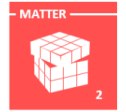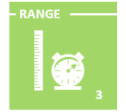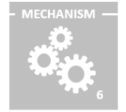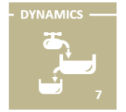Scales - ¨Business Scalability¨ 
(The operational range)

The Scales: how much activity the organization performs, with regard to the size of the economic environment.
Defining the Scales of the Business Activity is defining the "Business Scalability": determining, for each major process:
- Calibration: the alignment of operations' magnitude regarding relevant business scales.
- Duplicability: the ability of a given business process to be replicated in a slightly different configuration.
- Leverageability: the ability of a business process to increase its output without increasing its inputs by the same proportion.
Different levels of scales should be considered when defining the Scalability of a business in a given "Business Phase":
- Macro-Scales (Scales whose size is large compared to the magnitude of the Business activity): The business activity takes place at a given level of the Macro-Scales (ex: accounting software restricted to the dentists market). Calibration of the business activity with regard to macro-scales can be considered as "business share".
- Meso-Scales (Scales whose size is comparable to the magnitude of the Business activity): The business activity may be dependent on the size of Meso-Scales (ex: accessories associated with products introduced by a market leader). Calibration of the business activity with regard to meso-scales can be considered as size-wise "business coupling".
- Micro-Scales (Scales whose size is small compared to the magnitude of the Business activity): The business activity may be tailored to adapt to Micro-Scales (ex: production activity adapted to the changing demand level for each product reference). Calibration of the business activity with regard to micro-scales can be considered as size-wise "business tuning".

Cycles are associated with each Super-Process, and can therefore be split in 3 categories:
- Market Scales: scalability for Value Generation & Delivery (VG&D)
- Capture Scales: scalability for Value Contracting & Capture (VC&C)
- Industry Scales: scalability for Value Integration & Maintenance (VI&M)
(click on the following elements for more details)
> Market Scales
(Operational range for VG&D)
Calibration:
- Macro Scale (business share): the Marcro-Scale for a Market process is basically the total amount of associated targets’ needs. Calibration of a Market process with regard to its related Market Macro-Scale is the actual or expected market share (in terms of delivered value). For example, Whatsapp has a large market share when considering the need of instant messages on smartphones (although it has a small market share in terms of revenues compared to operators that charge for sms)
- Meso Scale (coupling): Delivery of space flights by Virgin Galactic will be, at least for their next business phase, restricted by the scale of its main resource: its spacecraft fleet. Several Boeing providers are exclusive; for them, production is directly linked to the level of demand from their unique customer.
- Micro Scale (tuning): Hospitals need to adjust the extent of their activity of their ER services to the level of daily cases they have to handle.
Duplicability:
Duplicability, for a Market process, can mean generating and delivering the same value in the same way, but in a different place or at a different time:
- For most capital-intensive businesses requiring large infrastructures to deliver their services, like mobile network operators for example, the value delivery process is hard to duplicate. To set-up its services in Europe, Verizon would have to build a large telecom network or acquire an existing carrier.
- On the other hand, for a consulting company, delivering its services in a new territory is much simpler. For example, Accenture has local operations in more than 50 countries.
Duplicability may also be achieved by following a similar process, but changing one or more of its elements, at a tactical level. For instance:
- using other supplies (ex: a red fruit smoothie producer extending its offer with other fruits)
- using a new resource (ex: a novel publisher adding new references to its library, or an electronics manufacturer investing in better machines)
- offering another product (ex: a new successful perfume brand willing to renew its operation with a new fragrance)
- offering another value proposition (ex: an auditing company starting to offer management consulting services)
- serving a new target segment (ex: Men’s Health publisher launched the spin-off Women’s Health)
Leverageability:
Typically, the software business is very leverageable in terms of product “manufacturing” and delivery: with the game Angry Birds, by using Apple’s application platform, the resources to deliver to 1 million customers is not much different from the one required to deliver 1000.
SaaS (or "Mobile SaaS") is another example of leverageable service: for Whatsapp, if delivering messaging services for 1 million users required a certain amount of hardware and software resources, delivering the same service to a hundred times more people did not require a hundred times more hardware resources, and did not require a new software (maybe some adaptations).
On the contrary, the consulting business is usually very poorly leverageable (unless it chooses a franchising model): if Accenture wants to perform the same number of missions in Europe as it does in the US, it more or less has to hire the same number of employees.
For industrial businesses in particular, “economies of scales” constitute a usual path to Market process leverageability.
> Capture Scales
(Operational range for VC&C)
CAPTURE ON CUSTOMERS’ SIDE
Calibration:
- Macro Scale (business share): the Marcro-Scale for a Capture process (on customers’ side) is basically the total amount of targeted customers’ budgets (for the associated needs in the transaction). Calibration of a Capture process with regard to its related Capture Macro-Scale is the actual or expected market share (in terms of revenues). For example, Google has a substantial market share when considering companies’ advertising budgets.
- Meso Scale (coupling): Zynga’s capture process (and therefore its capacity to generate revenue) is dependent on the scale of Facebook’s network. Cloud Sherpas proposes cloud solutions to enhance the use of Salesforce services; as a result, the extent of its sales activity is linked to the adoption level of Salesforce by companies.
- Micro Scale (tuning): In the banking industry, the activity level of sales officers can fluctuate depending on economic and political events.
Duplicability:
Duplicability, for a Capture process (on customers’ side), can mean contracting and capturing revenues in the same way, but in a different place or at a different time:
- For some organizations, duplicability of the Capture process can be straightforward: professional software editors may hire local sales representatives to contract with customers, just the same way they do it in the regions where they are already active.
- On the contrary, many reasons can make such duplicability more difficult: specific regulations may change the sales process for pharmaceutical companies. Or different levels of budget per customer in developing countries may require a different sales approach for consumer goods manufacturers, etc.
Duplicability may also be achieved by following a similar process, but changing one or more of its elements, at a tactical level. For instance:
- using other supplies (ex: using Google add placement platform after using Facebook’s)
- using a new resource (ex: using a new brand to sell a similar product)
- contracting with a new customer segment (ex: a flower delivery company, successful with restaurants, may decide to sell to hotels as well)
- using another contracting channel (ex: mobile application editors selling through the Google platform after a success on the Apple channel; or a smartwatch manufacturer selling through its web site after allowing “pre-sales” on Kickstarter)
- using another receipt channel (ex: Google is setting-up partnerships with mobile carriers to let people purchase apps through their mobile account)
Leverageability:
Thanks to a “network effect”, often based on web social networks, some application editors can reach leverageability for their capture process. For products such as Whatsapp, the more users adopt the application, the easier it is to convince other users. Word-of-mouth is another way to reach capture process leverageability: a good game will get easier and easier to sell as players adopt it.
On the contrary, businesses that are more traditional often lack leverageability for their capture process: selling health insurance does not require much less resources or supplies as the number of customers grows.
CAPTURE ON SOURCES’ SIDE
Calibration:
- Macro Scale (business share): the Marcro-Scale for a Capture process (on sources’ side) is basically the total amount of available associated supplies from sources. Calibration of a Capture process with regard to its related Capture Macro-Scale is the actual or expected “sourcing share”. This mostly makes sense in industries with scares supplies, or in the case of oligopoly (or at least when the number of buyers/acquirers is small). Airbus has a large sourcing share for commercial aircraft engines; Facebook has a large sourcing share when considering Internet users’ attention.
- Meso Scale (coupling): In several countries, hospitals recruitment in some specialties, like anesthesiology, is dependent on the number of available practitioners on the market.
- Micro Scale (tuning): Luxury restaurants may have to adapt their purchasing activity to day-to-day availability of perishable and scares goods.
Duplicability:
Duplicability, for a Capture process (on sources’ side), can mean contracting and capturing the same supplies in the same way, but in a different place or at a different time:
- Groupon’s merchant acquisition process is highly duplicable: what was done in Boston at the beginning was then duplicated in other major cities in the US and then all over the world.
- On the contrary, many reasons may make a Capture process difficult to duplicate: in some countries, it may be hard for a restaurant chain to purchase the right ingredients, that therefore need to be imported; local business habits may impose the use of intermediate contractors; supplies that are usually bought online may not be available in the same way in other countries etc.
Duplicability may also be achieved by following a similar process, but changing one or more of its elements, at a tactical level. For instance:
- using new supplies (ex: using a procurement service provider for some purchases)
- using a new resource (ex: using a procurement software to manage the increase of purchases)
- capturing different supplies (ex: a food producer may purchase palm oil instead of soybean oil, when duplicating its business in other regions of the world)
- contracting with a new source segment (ex: starting to purchase from a wholesaler supplies that used to be bought directly from the suppliers)
- using another contracting channel (ex: switching to online purchasing for some supplies)
- using another reception scheme (ex: receiving per batch instead of receiving based on customer orders)
Leverageability:
For supplies that are not scares, purchasing is usually, by essence, a leverageable process: the more an organization wants to buy, the less it requires in terms of inputs and in terms of money. On the contrary, for supplies that are very scares, it is harder to benefit from a leverageable purchasing process.
For capture processes involving contributors, the “network effect” can, again, play an important role: it was much harder for Facebook to get its first million users that it was to get its last.
> Industry Scales
(Operational range for VI&M)
Calibration:
- Macro Scale (business share): the Marcro-Scale for an Industry process is basically the total amount of associated infrastructures in the industry. Calibration of an Industry process with regard to its related Industry Macro-Scale is the actual or expected “industry share”. For example, Free Mobile, a recent French wireless carrier, has more than 10% of the national subscribers, but deployed only a small fraction of its competitors’ network infrastructure (especially antennas).
- Meso Scale (coupling): in the upstream oil & gas business, the building of Shell’s drilling platforms around the world is limited by the number of accessible (physically and legally) oil reserves.
- Micro Scale (tuning): for Parrot, a company developing products connected to mobile phones, all phones that are launched in the market without respecting 100% of connectivity standards may require new software adaptations.
Duplicability:
Duplicability, for an Industry process, can mean integrating and maintaining the same resources in the same way, but in a different place or at a different time:
- With globalization, many industrial companies duplicate their infrastructure building processes (ex: Honda builds factories in different countries), or their infrastructure improvement processes (ex: Cemex uses standard methods to modernize the cement plants they acquire around the world)
- On the other hand, resource integration and maintenance can, in some cases, be hard to duplicate. The way to train and motivate human resources, for a startup created in the Silicon Valley, may be difficult to duplicate in other parts of the world.
Duplicability may also be achieved by following a similar process, but changing one or more of its elements, at a tactical level. For instance:
- using new supplies (ex: for a social media agency, using new providers of web user profiles)
- using a new resource (ex: using CAD software to develop new products)
- building different resources (ex: Rovio Entertainment, creator of Angry Birds, developing special editions in consecutive years; Apple regularly developing new iPhones)
- operating through new activities (ex: training employees through online tools rather than through traditional lectures)
Leverageability:
A resource building process can be leverageable when resources are built on each others. For BMW, it is much easier to develop a new version of the MINI now than it was originally to develop the first one: BMW uses a resource (a common platform) as a R&D starting point to develop a new resource (a new vehicle design).
The famous “learning curve” is also usual way to reach some leverageability for a resource-building process (especially in the case of R&D).
On the other hand, in some cases regulation can make resource-building processes hard to leverage. In the pharmaceutical industry for instance, the development of a new drugs always requires the same kind of specific procedures, impeding leverageability.
Cycles < PREVIOUS - NEXT > Competitiveness









